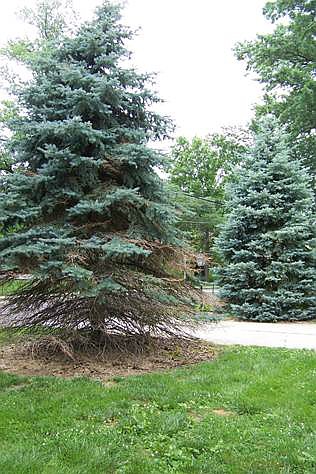Vegetables
Mulching underneath tomato plants is ideal to prevent foliar diseases, which often begin by splashing up from the soil, where they are harbored. The choice of the mulch is worth some consideration. Organic mulches like straw, old leaves or shredded wood are good, but will suppress soil temperatures. This can aggravate root rots if the spring is cool and wet. An ideal alternative is use of landscape fabric or weed barrier. This black material will warm the soil and let moisture through.
When I teach classes on vegetable gardening, I like to say growing vegetables organically in Missouri is generally easy, if you don't grow Cucurbits. The Cucurbit family includes cucumbers, squash (winter or summer), pumpkins and melons. They are plagued by three insect pests and several diseases. The two worst insect pests are cucumber beetles and squash bugs, for which there is a lack of effective organic insecticides available (permethrin is the best synthetic option). Treat at the first sign of cucumber beetles, otherwise it may transmit the deadly bacterial wilt disease, most problematic to cucumbers, cantaloupes and zucchini. There is no fungicide to control bacterial wilt. Retreat with insecticide whenever cucumber beetles or squash bugs are seen. To protect bees (which are needed for pollination) apply the insecticide in the evening. Including a spreader sticker improves the efficacy of the insecticide.
Trees
April is an ideal month to plant a potted tree, but May is OK as well. The selection at garden centers is optimum, and soil conditions are generally good. Preparing the soil a week or two in advance will benefit the soil condition at planting and make the act of planting go quicker. Remember to water weekly through the summer when rainfall is short. Establishing a mulch ring around the tree of 2-3 feet in diameter will conserve moisture and reduce watering demands.
Evergreen trees have had a tough time the last number of years in Missouri. Spruces were considered safe for Missouri in regards to foliar diseases but in recent years have struggled with rhizosphaera needlecast, and SNEED (Sudden Needle Drop of Spruce) with blue spruce the most susceptible. Both of these diseases and bagworms can be prevented with two foliar pesticide applications, the first toward the end of May and the second following in 2-3 weeks. The ideal growth stage for the first application is when the bud cap falls off the candles as it pushes. Two common broad spectrum fungicide remedies are chlorothalonil (e.g. Ortho Daconil) or a copper containing product. Effective insecticides are the active ingredients permethrin and spinosad. The fungicide and insecticide can be mixed together, with their effectiveness improved with the addition of a spreader sticker.
Fruits
Thinning of peaches will benefit disease and insect control as well as increase fruit size. Perform this task when they are nickel to quarter sized, and this is generally about the end of April or early May. Apple thinning is needed when they flower strongly, followed by good fruit set. Thinning helps control a biennial bearing pattern, where strong fruit set suppresses flowering the following year. Thin to one apple per cluster, and as with peaches, it will improve fruit resistance to insect and disease problems.
Berry gardeners (especially blackberry, raspberry, blueberry and mulberry) need to be observant of potential damage from Spotted Wing Drosophila. This invasive fruit fly can lay eggs in the fruit a week or two before it ripens and then ripe fruit breaks down with maggots inside - yuk! I call it the "mushy berry syndrome." Aggressive picking (upon ripening), sanitation and weekly treating with insecticides will bring the pest under control. Send me an email, and I will give you a link to a Lincoln University fact sheet on controlling this pest.

